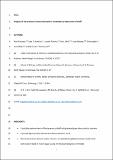Files in this item
Analysis of the product streams obtained on butanosolv pretreatment of draff
Item metadata
| dc.contributor.author | Foltanyi, Flora | |
| dc.contributor.author | Hawkins, Julie E. | |
| dc.contributor.author | Panovic, Isabella | |
| dc.contributor.author | Bird, Eve J. | |
| dc.contributor.author | Gloster, Tracey | |
| dc.contributor.author | Lancefield, Christopher S. | |
| dc.contributor.author | Westwood, Nicholas J. | |
| dc.date.accessioned | 2021-08-17T23:39:51Z | |
| dc.date.available | 2021-08-17T23:39:51Z | |
| dc.date.issued | 2020-10 | |
| dc.identifier | 269675604 | |
| dc.identifier | 0cb6cf0a-9fc9-46de-82cf-531e112d7976 | |
| dc.identifier | 85089507188 | |
| dc.identifier | 000572854500005 | |
| dc.identifier.citation | Foltanyi , F , Hawkins , J E , Panovic , I , Bird , E J , Gloster , T , Lancefield , C S & Westwood , N J 2020 , ' Analysis of the product streams obtained on butanosolv pretreatment of draff ' , Biomass and Bioenergy , vol. 141 , 105680 . https://doi.org/10.1016/j.biombioe.2020.105680 | en |
| dc.identifier.issn | 0961-9534 | |
| dc.identifier.other | ORCID: /0000-0003-0630-0138/work/79226707 | |
| dc.identifier.other | ORCID: /0000-0001-7951-3682/work/79226876 | |
| dc.identifier.uri | https://hdl.handle.net/10023/23792 | |
| dc.description | The authors would like to thank the University of St Andrews Interdisciplinary PhD funding scheme (F.F. studentship) and the EPSRC-funded CRITICAT Centre for Doctoral Training (studentship to I.P.; EP/L016419/1) for PhD funding. C.S.L. is funded by a Leverhulme Trust Early Career Fellowship (ECF-2018-480) and the University of St Andrews. This project was supported by a grant from the Lignocellulosic Biorefinery Network (LBNet), a BBSRC-funded Network in Industrial Biotechnology and Bioenergy (BBSRC NIBB) BB/L013738/1ss (N.J W., J.E.H and E.J.B.). | en |
| dc.description.abstract | The efficient use of biomass-derived waste streams from the food and drink industry is very important for achieving a circular economy. In this work, a pretreatment based on 1-butanol (butanosolv) was used to fractionate draff, a by-product from the brewing and distilling industries, leading to a solid pulp, a hemicellulose derived-fraction and a pseudo lignin. The pulp was enriched in glucans and showed a 4-fold improvement in enzymatic hydrolysis experiments relative to the starting biomass. The pulp could be fermented in an ABE process producing 32g/100g of solvents. The hemicellulose-derived fraction was analysed by 2D HSQC NMR and found to contain a mixture of predominantly butoxylated monosaccharides. The hydrolase enzymes present in Cellic® CTec3 were used to hydrolyse selectively the glucose and xylose derived butyl β-pyranose monomers. Alternatively, non-selective hydrolysis of both anomers was achieved using TFA/H2O giving native sugars for fermentation and recovered 1-butanol. A detailed characterization of the pseudo lignin was also achieved. | |
| dc.format.extent | 1671264 | |
| dc.language.iso | eng | |
| dc.relation.ispartof | Biomass and Bioenergy | en |
| dc.subject | Sustainable chemistry | en |
| dc.subject | Biomass | en |
| dc.subject | Draff | en |
| dc.subject | ABE fermentation | en |
| dc.subject | Hemicellulose | en |
| dc.subject | QD Chemistry | en |
| dc.subject | T Technology | en |
| dc.subject | NDAS | en |
| dc.subject | SDG 8 - Decent Work and Economic Growth | en |
| dc.subject | SDG 12 - Responsible Consumption and Production | en |
| dc.subject.lcc | QD | en |
| dc.subject.lcc | T | en |
| dc.title | Analysis of the product streams obtained on butanosolv pretreatment of draff | en |
| dc.type | Journal article | en |
| dc.contributor.sponsor | EPSRC | en |
| dc.contributor.sponsor | The Leverhulme Trust | en |
| dc.contributor.institution | University of St Andrews. School of Biology | en |
| dc.contributor.institution | University of St Andrews. School of Chemistry | en |
| dc.contributor.institution | University of St Andrews. EaSTCHEM | en |
| dc.contributor.institution | University of St Andrews. Biomedical Sciences Research Complex | en |
| dc.identifier.doi | https://doi.org/10.1016/j.biombioe.2020.105680 | |
| dc.description.status | Peer reviewed | en |
| dc.date.embargoedUntil | 2021-08-18 | |
| dc.identifier.grantnumber | EP/L016419/1 | en |
| dc.identifier.grantnumber | ECF-2018-480 | en |
This item appears in the following Collection(s)
Items in the St Andrews Research Repository are protected by copyright, with all rights reserved, unless otherwise indicated.

